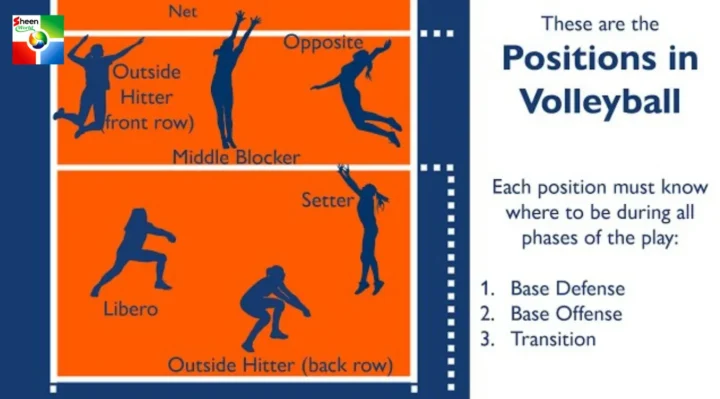
At a glance Volleyball
Volleyball is a dynamic and fast-paced sport that requires teamwork, strategy, and skill. Each player on the court has a specific role, contributing to the overall success of the team. This blog will provide an in-depth look at the various positions in volleyball, their responsibilities, and how they work together to achieve victory.
The Basics of Volleyball Positions
Overview of Volleyball Positions
In volleyball, there are six primary positions on the court, each with its own unique responsibilities. Understanding these positions is crucial for players, coaches, and fans alike.
The Six Positions
- Outside Hitter (Left Side Hitter)
- Middle Blocker
- Right Side Hitter (Opposite Hitter)
- Setter
- Libero
- Defensive Specialist
The Importance of Each Position
Each position plays a vital role in both offense and defense. The combination of these roles creates a balanced team capable of executing various strategies.
Detailed Breakdown of Volleyball Positions
Outside Hitter
The Outside Hitter is one of the most versatile positions in volleyball, responsible for both attacking and defending.
Responsibilities
- Attacking: The outside hitter is often the primary attacker, taking swings at the ball to score points.
- Passing: They need to be proficient in serve-receive situations, helping to pass the ball to the setter.
- Defense: Outside hitters also play an essential role in defense, covering tips and blocks from opponents.
Skills Required
- Strong hitting and spiking ability.
- Excellent passing and ball control.
- Good defensive skills, including digging.
Middle Blocker
The Middle Blocker is crucial for the team’s defense, particularly at the net.
Responsibilities
- Blocking: The primary responsibility of the middle blocker is to block opposing hitters.
- Attacking: They also execute quick attacks, often referred to as “middle attacks,” after the setter delivers the ball.
- Coverage: Middle blockers must be aware of their surroundings to assist in defense against tips and off-speed shots.
Skills Required
- Quick reflexes and timing for effective blocking.
- Strong vertical jump for attacking and defending.
- Good communication skills to coordinate with the setter.
Right Side Hitter (Opposite Hitter)
The Right Side Hitter, also known as the Opposite Hitter, plays a vital role in both offense and defense.
Responsibilities
- Attacking: They attack from the right side of the court, often facing strong blocks from the opponent’s outside hitters.
- Blocking: Like the middle blocker, the right side hitter plays a significant role in blocking opposing attacks.
- Defense: They also need to be good at digging and covering tips.
Skills Required
- Strong hitting ability, particularly from the back row.
- Good blocking skills to counter opposing hitters.
- Ability to read the game and make quick decisions.
Setter
The Setter is often referred to as the “quarterback” of the volleyball team, orchestrating the offense.
Responsibilities
- Setting: The primary duty of the setter is to deliver accurate sets to the hitters, allowing them to maximize their attacking potential.
- Decision-Making: Setters must quickly decide which hitter to set based on the defense’s positioning.
- Defense: While their main focus is on setting, they also play a role in defense, especially in serve-receive situations.
Skills Required
- Exceptional ball control and accurate setting.
- Quick decision-making skills.
- Good communication with teammates.
Libero
The Libero is a specialized defensive player who wears a different color jersey and cannot attack the ball above the net.
Responsibilities
- Defense: The primary role of the libero is to receive serve and play defense in the back row.
- Serve Receive: They often take the first pass, allowing the setter to have a better angle for setting.
- Ball Control: Liberos must have excellent passing skills and court awareness.
Skills Required
- Exceptional digging and passing ability.
- Quick reflexes and agility.
- Strong communication skills to lead the defense.
Defensive Specialist
The Defensive Specialist is similar to the libero but is not restricted in the same way.
Responsibilities
- Defense: Primarily focused on playing defense and serve-receive.
- Substitution: They often substitute for front-row players to enhance the team’s defensive capabilities.
- Support: Provide additional passing support to the setter.
Skills Required
- Strong defensive skills, particularly in passing and digging.
- Ability to read the game and anticipate plays.
- Good communication with teammates.
Understanding Rotations and Positions on the Court
The Volleyball Rotation System
Each team must rotate positions after winning the serve from the opponent, which affects player positioning on the court.
Rotational Order
- Position 1: Right Back (Server)
- Position 2: Middle Back
- Position 3: Left Back
- Position 4: Left Front (Outside Hitter)
- Position 5: Middle Front (Middle Blocker)
- Position 6: Right Front (Right Side Hitter)
Impact of Rotations on Player Positions
Understanding how rotations work is crucial for players to know when they will be in the front row or back row and how this affects their roles.
Key Strategies for Each Position
Offensive Strategies
Each position has specific strategies that can enhance the team’s offensive capabilities.
Outside Hitter Strategies
- Cross-Court Hits: Targeting the deep corners of the court.
- Quick Sets: Timing the attack with the setter for fast plays.
Setter Strategies
- Mixed Sets: Varying the types of sets (high, quick, back sets) to keep the defense guessing.
- Setter Dumps: Occasionally attacking instead of setting to surprise the defense.
Defensive Strategies
Defensive strategies are crucial for preventing the opposing team from scoring.
Middle Blocker Strategies
- Reading the Opponent: Anticipating the hitter’s approach to position effectively for blocking.
- Solo and Double Blocks: Coordinating with teammates to create effective block formations.
Libero Strategies
- Positioning: Staying low and ready to move quickly for digs and passes.
- Communication: Directing the defense and ensuring strong coverage.
Training and Development for Volleyball Positions
Importance of Position-Specific Training
Understanding the specific skills required for each position is essential for player development.
Drills for Each Position
- Outside Hitter: Hitting drills, serve-receive drills, and defensive positioning.
- Setter: Setting drills, footwork drills, and communication drills.
Continuous Improvement
Players should regularly assess their performance and seek feedback to improve their skills in their designated positions.
Conclusion
Understanding the various positions in volleyball is crucial for players, coaches, and fans. Each position contributes uniquely to the team’s dynamics, and mastering the specific skills required for each role enhances overall team performance.
As players continue to develop and adapt, the strategies and techniques associated with each position will evolve, ensuring that volleyball remains a thrilling and competitive sport. Whether you’re a seasoned player or just starting, embracing the intricacies of volleyball positions will enrich your experience and understanding of this beloved game.



